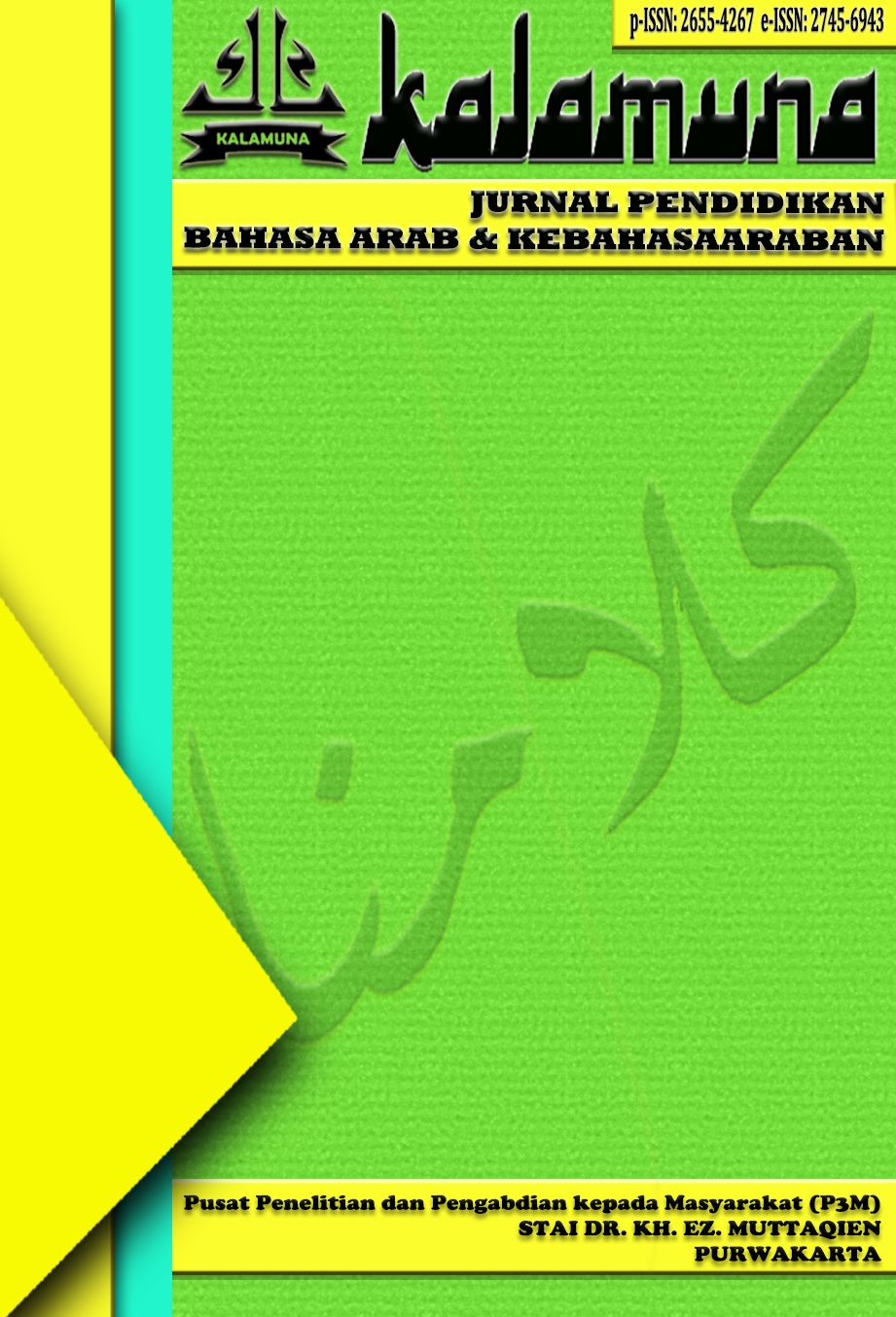Enhancing Arabic Writing and Literacy through Ibda’ Magazine: A Culturally Relevant Medium in Islamic Boarding Schools
Keywords:
Arabic Writing Skills, Authentic Learning, Student Magazine, Literacy Development, Islamic Boarding SchoolAbstract
In Arabic language education, writing remains one of the most underdeveloped yet essential skills, particularly for non-native learners who often excel in grammar drills but struggle to produce coherent and expressive texts. This study explores the role of Ibda’ Magazine as an authentic, student-centered platform to enhance Arabic writing skills and literacy among 60 third-year Tsanawiyah students at Pondok Pesantren Darullughah Wadda’wah. Using a qualitative descriptive design, the research draws on thematic analysis of student writings, classroom observations, and semi-structured interviews with both learners and instructors. The findings reveal significant improvement in students' vocabulary use, grammatical accuracy, narrative coherence, and stylistic expression. Additionally, learners reported increased confidence, motivation, and a deeper sense of ownership over their Arabic writing. The study affirms that culturally relevant, print-based media can serve as powerful pedagogical tools in bridging the gap between formal instruction and meaningful language practice, offering new pathways for Arabic writing development in Islamic educational settings.
References
Adeshola, I., & Adepoju, A. P. (2024). The opportunities and challenges of ChatGPT in education. Interactive Learning Environments, 32(10), 6159–6172. https://doi.org/10.1080/10494820.2023.2253858
Al Aghar, T., Demirci, H. C., Houjeir, R., McMinn, M., & Ali Saif Alzaabi, K. (2023). Investigating Arabic teachers’ perceptions of extensive reading practices in higher education. Cogent Education, 10(1), 2162701. https://doi.org/10.1080/2331186X.2022.2162701
Al Sharoufi, H. (2022). Towards a unified English technology-based writing curriculum in the Arabian Gulf countries: The case of Oman. Language Testing in Asia, 12(1), 33. https://doi.org/10.1186/s40468-022-00178-1
Alhamami, M. (2023). Inequity, inequality, and language rights in English as a medium of instruction programs. Evaluation and Program Planning, 99, 102297. https://doi.org/10.1016/j.evalprogplan.2023.102297
Alsaied, M. A. (2024). The Contribution of Artificial Intelligence Technologies in Refining the Arabic Language Skills of Its Native Speakers: Achieved and Possible. Journal of Ecohumanism. https://doi.org/10.62754/joe.v3i8.5126
Baharun, S., & Hanifansyah, N. (2024). Efektivitas Pembelajaran Kitab Al-Af’al Al-Yaumiyyah pada Daurah Ramadhan di Pon Pes Dalwa. Shaut Al-Arabiyah, 12(2). https://doi.org/10.24252/saa.v12i2.52825
Benanane, A. Y., Smail, L. L., & Ouahioune, A. (2024). Analysis of the Impact of Serious Games on the Development of Writing Skills in Intermediate-Level Students Learning French as a Foreign Language. International Journal of Serious Games. https://doi.org/10.17083/ijsg.v11i3.767
Creswell, J. W., & Creswell, J. D. (2020). Research Design: Qualitative, Quantitative, and Mixed Methods Approaches. SAGE Publications.
Hassanein, E. E. A., Johnson, E. S., Alshaboul, Y. M., Ibrahim, S. R., & Megreya, A. M. (2022). Examining Factors That Predict Arabic Word Reading in First and Second Graders. Reading & Writing Quarterly, 38(1), 51–66. https://doi.org/10.1080/10573569.2021.1907637
Herrington, J., & Oliver, R. (2000). An instructional design framework for authentic learning environments. Educational Technology Research and Development, 48(3), 23–48. https://doi.org/10.1007/BF02319856
Javaid, M., Haleem, A., Singh, R. P., Khan, S., & Khan, I. H. (2023). Unlocking the opportunities through ChatGPT Tool towards ameliorating the education system. BenchCouncil Transactions on Benchmarks, Standards and Evaluations, 3(2), 100115. https://doi.org/10.1016/j.tbench.2023.100115
Lovell, O., & Sherrington, T. (2020). Sweller’s Cognitive Load Theory in Action. Hodder Education. https://books.google.com.sg/books?id=qgOiEAAAQBAJ
Luthfi, K. M. (2025). Modern Arabic Language Idioms in the Silsilat Al-Lisan Arabic Language Learning Textbook. Theory and Practice in Language Studies. https://doi.org/10.17507/tpls.1503.12
Mahapatra, S. (2024). Impact of ChatGPT on ESL students’ academic writing skills: A mixed methods intervention study. Smart Learning Environments, 11(1), 9. https://doi.org/10.1186/s40561-024-00295-9
Mahmoud, Z., Li, C., Zappatore, M., Solyman, A., Alfatemi, A., Ibrahim, A. O., & Abdelmaboud, A. (2023). Semi-Supervised Learning and Bidirectional Decoding for Effective Grammar Correction in Low-Resource Scenarios. Peerj Computer Science. https://doi.org/10.7717/peerj-cs.1639
Mehdi, R. A. (2024). The Effect of a Genre-Based Approach and Translanguaging on Lebanese Upper Elementary Students’ Skills in Writing Explanations [AMERICAN UNIVERSITY OF BEIRUT]. http://hdl.handle.net/10938/24455
Naghdipour, B. (2021). English writing pedagogy at the crossroads: The case of Oman. Journal of Second Language Writing, 52, 100815. https://doi.org/10.1016/j.jslw.2021.100815
Nur Hanifansyah, Mahmudah, M., & Syakur, S. A. (2024). Peer Tutoring as a Collaborative Approach in Arabic Language Learning. Lahjatuna: Jurnal Pendidikan Bahasa Arab, 4(1), 26–43. https://doi.org/10.38073/lahjatuna.v4i1.2181
Nusair, L., & Palmer, R. (2023). Weak foundations in Arabic literacy: Drivers of learning poverty in Jordan. International Journal of Educational Development, 99, 102774. https://doi.org/10.1016/j.ijedudev.2023.102774
Palmer, E. (2023). Well Spoken: Teaching Speaking to All Students (1st ed.). Routledge. https://doi.org/10.4324/9781032683041
Qedear, A., AlMatrafy, A., Al-Sowat, A., Saigh, A., & Alayed, A. (2024). Real-Time Air-Writing Recognition for Arabic Letters Using Deep Learning. Sensors. https://doi.org/10.3390/s24186098
Rahman, L. (2024). Vygotsky’s Zone of Proximal Development of Teaching and Learning in STEM Education. IJERT, 13(8). https://doi.org/10.17577/IJERTV13IS080042
Santos, K. D. S., Ribeiro, M. C., Queiroga, D. E. U. D., Silva, I. A. P. D., & Ferreira, S. M. S. (2020). The use of multiple triangulations as a validation strategy in a qualitative study. O uso de triangulação múltipla como estratégia de validação em um estudo qualitativo. Ciência & Saúde Coletiva, 25(2), 655–664. https://doi.org/10.1590/1413-81232020252.12302018
Shafiee Rad, H., & Jafarpour, A. (2023). Effects of Well-being, Grit, Emotion Regulation, and Resilience Interventions on L2 Learners’ Writing Skills. Reading & Writing Quarterly, 39(3), 228–247. https://doi.org/10.1080/10573569.2022.2096517
Shendy, R. (2022). Learning to Read in an “Estranged†Language: Arabic Diglossia, Child Literacy, and the Case for Mother Tongue-Based Education. Scientific Research Publishing, 13(04), 1247–1301. https://doi.org/10.4236/ce.2022.134077
Solehudin, M., Hanifansyah, N., & Izzuddin, I. F. (2024). Enhancing Arabic Listening and Vocabulary Acquisition through AI-Powered Music: A Study on Suno AI. Arabiyat : Jurnal Pendidikan Bahasa Arab Dan Kebahasaaraban, 11(2), 175–188. https://doi.org/10.15408/a.v11i2.41994
Solyman, A., Wang, Z., Tao, Q., Mohammed Elhag, A. A., Toseef, M., & Aleibeid, Z. (2021). Synthetic Data With Neural Machine Translation for Automatic Correction in Arabic Grammar. Egyptian Informatics Journal. https://doi.org/10.1016/j.eij.2020.12.001
Yaghoubi, M., & Farrokh, P. (2022). Investigating Iranian English Learners’ Private Speech Across Proficiency Levels and Gender Based on Vygotsky’s Sociocultural Theory. Journal of Psycholinguistic Research, 51(2), 273–292. https://doi.org/10.1007/s10936-022-09838-y













